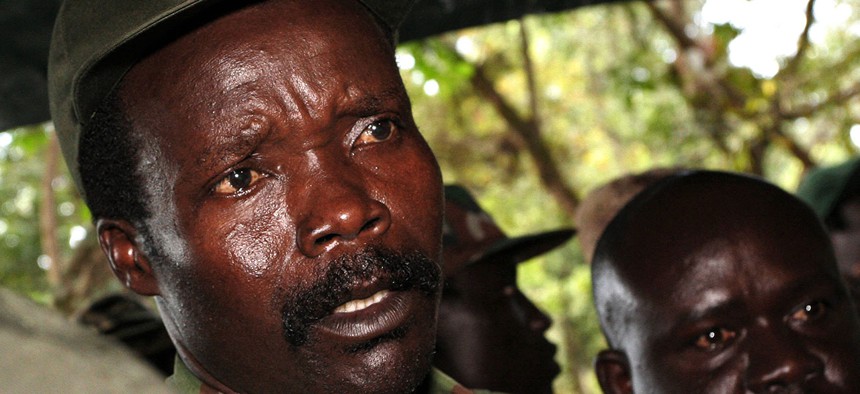
The leader of the Lord's Resistance Army Joseph Kony answers journalists' questions following a meeting with UN humanitarian chief Jan Egeland at Ri-Kwangba in southern Sudan in 2006 Stuart Price/AP file photo
How US Special Operators Helped Take Down Joseph Kony’s Army With Tailored Messages
For six years, an elite Army team waged psychological warfare against a murderous warlord. Here’s how they won.
In 2011, the Obama administration had a big problem. A violent rebel group called the Lord’s Resistance Army, or LRA, led by warlord Joseph Kony, was terrorizing portions of South Sudan, the Congo, the Central African Republic, and particularly Uganda. Kony had kidnapped more than 60 children, many of whom he had pressed into service as fighters. The administration was seeing rising public concern…and there was an election coming.
Like previous administrations, they turned to a small team of elite soldiers that (they hoped) could tackle the problem quietly, in a way that could minimize the overt American presence and keep costs down: the U.S. Army’s psychological operations soldiers of it's special operations forces.
As part of a broader effort, experts in PSYOPs, or what is called Military Information Support Operations, or MISO, undertook a unique mission: disintegrating the Lord’s Resistance Army by finding key members of Kony’s gang and persuading them to defect. It was a difficult task under almost any circumstance, but doubly so against marauders moving constantly through thick jungle across national borders.
“In the beginning, we had broad target audiences. Knowing that most of the LRA combatants were child soldiers who had been abducted, we assessed that they were susceptible to defection,” Army Col. Bethany C. Aragon told a crowd at a conference in Washington, D.C. last week, heavily attended by Army folk.
The job was to figure out who did what in Kony’s Army and how to reach them. That might seem easy, but these guys weren’t big Facebook users. “It was significantly dense jungle. The best means to access our target audience was through radio, leaflets, aerial loudspeaker operations,” said Aragon.
What was the message? It began as a general sales pitch: leave the Lord’s Resistance Army and you won’t be prosecuted.
“The Ugandan government decided to offer amnesty to LRA combatants who did defect,” said Aragon. “For the defection campaign to be successful, we had to make sure that when combatants defected, they had to be treated fairly.”
The plan was to disarm and demobilize the deserters, send them back to their home countries, and help them reintegrate into the social fabric to turn them off to extremism.
The operation relied on a lot of partners, and not just other African governments and the Ugandan People’s Defense Force. Others included local leaders; advocacy groups such as Pathways to Peace and Invisible Children (the organization behind the famous #Kony2012 movement); and even the families of Kony’s soldiers. These partners brought crucial information to help the Special Forces target their messages.
“What we were able to do is identify key leaders within the LRA that were prone to defection who would then be able to inspire multiple defections,” Aragon said.
Most importantly, the communications would have to ring true: LRA members had to believe that they would be able to return home and not be jailed or worse, which was what Kony was telling them would happen, Aragon said.
Message by message, defection by defection, the operation built momentum. Every soldier who left Kony’s organization provided data to fill in the organizational chart and help the U.S. troops and their allies improve their targeting and persuading. “We would de-brief them, learn more information, use them to create products,” said Aragon.
In January, the group achieved another key victory: the defection of Michael Omono, Joseph Kony’s personal radio telephone operator. As RTO, Omono knew essentially everything about what Kony said to anyone under his command, when he communicated with troops, and how. After Pathways to Peace tracked down Omono’s mother, his daughter, and his uncle, the team convinced the family to help. What followed was a textbook example of military psychological operations, or psy-ops.
“Envision yourself walking through dense jungle,” Aragon said. “You are working for a leader who is clearly unhinged and not inspired by the original motivations that people join the Lord’s Resistance Army for. [Omono] is susceptible. Then, as he’s walking through the jungle, he hears [a recording of] his mother’s voice and her message begging him to come home. He sees leaflets with his daughter’s picture begging him to come home, from his uncle that raised him and was a father to him.”
Omono left the LRA and walked for two weeks through tropical forests to turn himself into the African Union regional task force. That single defection turned out to be hugely significant.
“Because he was the RTO, we got valuable information from him that let us know when their communication windows were. They had a special code language that they would use. He gave us the key to that. It was monumental in rapidly ending the LRA’s effectiveness in the area.”
Over the summer, the special operations team wrapped up the mission; Aragon said they rendered LRA “irrelevant.” An army of 2,000 fighters had been whittled to fewer than 100. The LRA had nearly ceased to inflict casualties. More than 500 of its former leaders were either dead or on trial.
A Model Operation
The Kony operation provides a model for information and psychological operations, which are growing in importance as the Internet and social networks make more information about specific individuals readily available. But such activities are somewhat at odds with the military’s traditional pursuits of fighting, taking territory, and controlling it by force.
Gearing up for psychological operations requires a culture shift, a willingness to embrace a new mission set that’s somewhat different from the Hollywood vision of Special Forces — lesser in terms of clear fighting missions and objectives, greater in terms more nuanced missions and murkier objectives. Victory is measured in minds changed, human behaviors altered. Some parts of the military are a more eager for it than others.
“In this changing geopolitical/technical landscape, it is increasingly clear that the DOD needs to complement ‘control’ with an explicit focus upon ‘influence’ factors and forces that produce desired behavioral outcomes across complex and intermeshed human and technical systems.” notes Brig. Gen. Alexus G. Grynkewich, the deputy director of global operations for the Joint Staff, in the preface to a Pentagon Strategic Multilayer Assessment dated August 2017 and obtained exclusively by Defense One. “Influence is critical in conflicts such as those in the Gray Zone, whose limited nature leaves adversaries and allies able to choose,” he writes, referring to the type of fighting where the enemy blends into the civilian population, becoming, in a sense, invisible.
The collection of essays, primarily from academics, goes on to describe new ways that the military can better target messages to individuals and entire populations, including chapters on “Neuroscience and Technology as Weapons on the 21st Century World Stage.”
Much of it focuses on future fighting in the domain of hearts, minds and perceptions of reality, and how important those skills will be in the event a major conflict with an enemy that the military euphemistically calls “a near-peer competitor” but that the rest of the world understands as China and particularly Russia.
Aragon (whose other writing on this is well worth reading) said the recipe for success is straightforward, but not simple. You need partners you can trust who live up to the commitments they make to the people you are trying to influence, like amnesty in exchange for defection. But most important, you have to have forces on the ground, collecting information on the adversary and building partnerships with groups that might be able to help you. And you need it long, long before the fighting even begins.
“We were reliant on a very capable and knowledgeable partner force and community of interest. It took time for us to build rapport and credibility with those partners, which is why there was a long lead time before we really experienced an increase in our effectiveness and an ability to target with precision certain leaders in the Lord’s Resistance Army,” she said. “We can’t wait until a deployment, particularly when it’s with that multi-domain battle against a near-peer competitor.”
CORRECTION: An original version of this article stated that the featured PSYOP soldiers were U.S. Army Special Forces, or Green Berets. Psychological operations soldiers are part of U.S. Army Special Operations Command. They frequently support Special Forces missions, but they are distinct from Green Berets.







